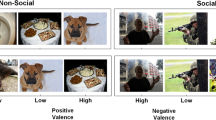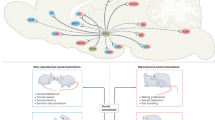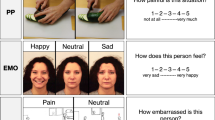Abstract
Oxytocin (OT) enhances social behaviors such as attachment and parental caretaking. Neural correlates of maternal attachment are found in reward-related brain regions, for example, in the globus pallidus (GP). The present work investigates the effects of OT on the neural correlates of parental attachment. Fathers viewed pictures of their own child (oC), a familiar child (fC), and an unfamiliar child (uC) after intranasal application of OT vs placebo. OT reduced activation and functional connectivity of the left GP with reward- and attachment-related regions responsive to pictures of the oC and the uC. The present results emphasize the key role of OT in human parental attachment and suggest that OT reduces neural reactivity to social cues as a function of social salience. Our results together with previous findings speak to a selective reduction of neural reactivity to social stimuli, irrespective of their valence. We argue that one major pathway by which OT exerts its positive effects on affiliative and social behaviors is the attenuation of automatic neural responses, which in turn leads to increased approach behaviors and decreased social avoidance.
Similar content being viewed by others
Log in or create a free account to read this content
Gain free access to this article, as well as selected content from this journal and more on nature.com
or
References
Acevedo BP, Aron A, Fisher HE, Brown LL (2011). Neural correlates of long-term intense romantic love. Soc Cogn Affect Neurosci 7: 145–159.
Bartels A, Zeki S (2000). The neural basis of romantic love. Neuroreport 11: 3829–3834.
Bartels A, Zeki S (2004). The neural correlates of maternal and romantic love. Neuroimage 21: 1155–1166.
Bartz J, Simeon D, Hamilton H, Kim S, Crystal S, Braun A et al (2010a). Oxytocin can hinder trust and cooperation in borderline personality disorder. Soc Cogn Affect Neurosci 6: 556–563.
Bartz JA, Zaki J, Bolger N, Ochsner KN (2011). Social effects of oxytocin in humans: context and person matter. Trends Cogn Sci 15: 301–309.
Bartz JA, Zaki J, Ochsner KN, Bolger N, Kolevzon A, Ludwig N et al (2010b). Effects of oxytocin on recollections of maternal care and closeness. Proc Natl Acad Sci USA 107: 21371–21375.
Baumgartner T, Heinrichs M, Vonlanthen A, Fischbacher U, Fehr E (2008). Oxytocin shapes the neural circuitry of trust and trust adaptation in humans. Neuron 58: 639–650.
Boorman ED, Behrens TEJ, Woolrich MW, Rushworth MFS (2009). How green is the grass on the other side? Frontopolar cortex and the evidence in favor of alternative courses of action. Neuron 62: 733–743.
Born J, Lange T, Kern W, McGregor GP, Bickel U, Fehm HL (2002). Sniffing neuropeptides: a transnasal approach to the human brain. Nat Neurosci 5: 514–516.
Buchheim A, Heinrichs M, George C, Pokorny D, Koops E, Henningsen P et al (2009). Oxytocin enhances the experience of attachment security. Psychoneuroendocrinology 34: 1417–1422.
Bunzeck N, Dayan P, Dolan RJ, Duzel E (2010). A common mechanism for adaptive scaling of reward and novelty. Hum Brain Mapp 31: 1380–1394.
Campbell A (2010). Oxytocin and human social behavior. Pers Soc Psychol Rev 14: 281–295.
D’Ardenne K, McClure SM, Nystrom LE, Cohen JD (2008). BOLD responses reflecting dopaminergic signals in the human ventral tegmental area. Science 319: 1264–1267.
Davidson RJ, Irwin W (1999). The functional neuroanatomy of emotion and affective style. Trends Cogn Sci 3: 11–21.
Deichmann R, Josephs O, Hutton C, Corfield DR, Turner R (2002). Compensation of susceptibility-induced BOLD sensitivity losses in echo-planar fMRI imaging. Neuroimage 15: 120–135.
Ditzen B, Schaer M, Gabriel B, Bodenmann G, Ehlert U, Heinrichs M (2009). Intranasal oxytocin increases positive communication and reduces cortisol levels during couple conflict. Biol Psychiatry 65: 728–731.
Domes G, Heinrichs M, Glascher J, Buchel C, Braus DF, Herpertz SC (2007). Oxytocin attenuates amygdala responses to emotional faces regardless of valence. Biol Psychiatry 62: 1187–1190.
Domes G, Lischke A, Berger C, Grossmann A, Hauenstein K, Heinrichs M et al (2009). Effects of intranasal oxytocin on emotional face processing in women. Psychoneuroendocrinology 35: 83–93.
Drabant EM, McRae K, Manuck SB, Hariri AR, Gross JJ (2009). Individual differences in typical reappraisal use predict amygdala and prefrontal responses. Biol Psychiatry 65: 367–373.
Feldman R, Gordon I, Schneiderman I, Weisman O, Zagoory-Sharon O (2010). Natural variations in maternal and paternal care are associated with systematic changes in oxytocin following parent-infant contact. Psychoneuroendocrinology 35: 1133–1141.
Frith U, Frith CD (2003). Development and neurophysiology of mentalizing. Philos Trans R Soc Lond B Biol Sci 358: 459–473.
George C, West M (2001). The development and preliminary validation of a new measure of adult attachment: the Adult Attachment Projective. Attach Hum Dev 3: 30–61.
Gobbini MI, Leibenluft E, Santiago N, Haxby JV (2004). Social and emotional attachment in the neural representation of faces. Neuroimage 22: 1628–1635.
Gordon I, Zagoory-Sharon O, Leckman JF, Feldman R (2010a). Oxytocin and the development of parenting in humans. Biol Psychiatry 68: 377–382.
Gordon I, Zagoory-Sharon O, Leckman JF, Feldman R (2010b). Prolactin, Oxytocin, and the development of paternal behavior across the first six months of fatherhood. Horm Behav 58: 513–518.
Griswold MA, Jakob PM, Heidemann RM, Nittka M, Jellus V, Wang J et al (2002). Generalized autocalibrating partially parallel acquisitions (GRAPPA). Magn Reson Med 47: 1202–1210.
Guendel H, Heinrichs M, Pokorny D, Koops E, Henningsen P, Buchheim A (2009). Influence of oxytocin on increased perception of binding security. Psychotherapie Psychosomatik Medizinische Psychologie 59: 82.
Guitart-Masip M, Bunzeck N, Stephan KE, Dolan RJ, Duzel E (2010). Contextual novelty changes reward representations in the striatum. J Neurosci 30: 1721–1726.
Gundel H, O’Connor M-F, Littrell L, Fort C, Lane RD (2003). Functional neuroanatomy of grief: an fMRI study. Am J Psychiatry 160: 1946–1953.
Hariri AR, Bookheimer SY, Mazziotta JC (2000). Modulating emotional responses: effects of a neocortical network on the limbic system. Neuroreport 11: 43–48.
Haxby JV, Hoffman EA, Gobbini MI (2000). The distributed human neural system for face perception. Trends Cogn Sci 4: 223–233.
Haxby JV, Hoffman EA, Gobbini MI (2002). Human neural systems for face recognition and social communication. Biol Psychiatry 51: 59–67.
Heinrichs M, Baumgartner T, Kirschbaum C, Ehlert U (2003). Social support and oxytocin interact to suppress cortisol and subjective responses to psychosocial stress. Biol Psychiatry 54: 1389–1398.
Heinrichs M, Domes G (2008). Neuropeptides and social behaviour: effects of oxytocin and vasopressin in humans. Prog Brain Res 170: 337–350.
Hong S, Hikosaka O (2008). The globus pallidus sends reward-related signals to the lateral habenula. Neuron 60: 720–729.
Insel TR (2010). The challenge of translation in social neuroscience: a review of oxytocin, vasopressin, and affiliative behavior. Neuron 65: 768–779.
Kanwisher N, Yovel G (2006). The fusiform face area: a cortical region specialized for the perception of faces. Philos Trans R Soc Lond B Biol Sci 361: 2109–2128.
Kirsch P, Esslinger C, Chen Q, Mier D, Lis S, Siddhanti S et al (2005). Oxytocin modulates neural circuitry for social cognition and fear in humans. J Neurosci 25: 11489–11493.
Kosfeld M, Heinrichs M, Zak PJ, Fischbacher U, Fehr E (2005). Oxytocin increases trust in humans. Nature 435: 673–676.
Kringelbach ML (2005). The human orbitofrontal cortex: linking reward to hedonic experience. Nat Rev Neurosci 6: 691–702.
Laux L, Glanzmann P, Schaffner P, Spielberger CD (1981). Das State-Trait-Angstinventar. Theoretische Grundlagen und Handanweisung. Beltz: Weinheim.
Leibenluft E, Gobbini MI, Harrison T, Haxby JV (2004). Mothers’ neural activation in response to pictures of their children and other children. Biol Psychiatry 56: 225–232.
Lim MM, Murphy AZ, Young LJ (2004). Ventral striatopallidal oxytocin and vasopressin V1a receptors in the monogamous prairie vole (Microtus ochrogaster). J Comp Neurol 468: 555–570.
Loup F, Tribollet E, Dubois-Dauphin M, Dreifuss JJ (1991). Localization of high-affinity binding sites for oxytocin and vasopressin in the human brain. An autoradiographic study. Brain Res 555: 220–232.
Maldjian JA, Laurienti PJ, Burdette JH (2004). Precentral gyrus discrepancy in electronic versions of the Talairach atlas. Neuroimage 21: 450–455.
Maldjian JA, Laurienti PJ, Kraft RA, Burdette JH (2003). An automated method for neuroanatomic and cytoarchitectonic atlas-based interrogation of fMRI data sets. Neuroimage 19: 1233–1239.
McGraw LA, Young LJ (2010). The prairie vole: an emerging model organism for understanding the social brain. Trends Neurosci 33: 103–109.
Meinlschmidt G, Heim C (2007). Sensitivity to intranasal oxytocin in adult men with early parental separation. Biol Psychiatry 61: 1109–1111.
Meyer-Lindenberg A, Domes G, Kirsch P, Heinrichs M (2011). Oxytocin and vasopressin in the human brain: social neuropeptides for translational medicine. Nat Rev Neurosci 12: 524–538.
Mitchell DG, Nakic M, Fridberg D, Kamel N, Pine DS, Blair RJ (2007). The impact of processing load on emotion. Neuroimage 34: 1299–1309.
Naber F, van IJzendoorn MH, Deschamps P, van Engeland H, Bakermans-Kranenburg MJ (2010). Intranasal oxytocin increases fathers’ observed responsiveness during play with their children: a double-blind within-subject experiment. Psychoneuroendocrinology 35: 1583–1586.
Northoff G, Hayes DJ (2011). Is our self nothing but reward? Biol Psychiatry 69: 1019–1025.
O’Connor MF, Wellisch DK, Stanton AL, Eisenberger NI, Irwin MR, Lieberman MD (2008). Craving love? Enduring grief activates brain's reward center. Neuroimage 42: 969–972.
Panksepp J (2009). Primary process affects and brain oxytocin. Biol Psychiatry 65: 725–727.
Pessoa L, Padmala S, Morland T (2005). Fate of unattended fearful faces in the amygdala is determined by both attentional resources and cognitive modulation. Neuroimage 28: 249–255.
Petrovic P, Ingvar M (2002). Imaging cognitive modulation of pain processing. Pain 95: 1–5.
Singer T, Snozzi R, Bird G, Petrovic P, Silani G, Heinrichs M et al (2008). Effects of oxytocin and prosocial behavior on brain responses to direct and vicariously experienced pain. Emotion 8: 781–791.
Sodickson DK, Manning WJ (1997). Simultaneous acquisition of spatial harmonics (SMASH): fast imaging with radiofrequency coil arrays. Magn Reson Med 38: 591–603.
Steyer R, Schwenkmezger P, Notz P, Eid M (1997). Der Mehrdimensionale Befindlichkeitsfragebogen MDBF [Multidimensional mood questionnaire]. Hogrefe: Göttingen, Germany.
Strathearn L, Li J, Fonagy P, Montague PR (2008). What's in a smile? Maternal brain responses to infant facial cues. Pediatrics 122: 40–51.
Theodoridou A, Rowe AC, Penton-Voak IS, Rogers PJ (2009). Oxytocin and social perception: oxytocin increases perceived facial trustworthiness and attractiveness. Horm Behav 56: 128–132.
Tzourio-Mazoyer N, Landeau B, Papathanassiou D, Crivello F, Etard O, Delcroix N et al (2002). Automated anatomical labeling of activations in SPM using a macroscopic anatomical parcellation of the MNI MRI single-subject brain. Neuroimage 15: 273–289.
van der Meer MAA, Redish AD (2011). Ventral striatum: a critical look at models of learning and evaluation. Curr Opin Neurobiol 21: 387–392.
Young LJ, Wang Z (2004). The neurobiology of pair bonding. Nat Neurosci 7: 1048–1054.
Acknowledgements
We thank all fathers and children who participated in the study, as well as their mothers and nursery schools for their cooperation. We also thank Mary-Frances O’Connor for comments on an earlier version of the manuscript.
Author information
Authors and Affiliations
Corresponding author
Ethics declarations
Competing interests
The authors declare no conflict of interest.
Additional information
Supplementary Information accompanies the paper on the Neuropsychopharmacology website
Supplementary information
PowerPoint slides
Rights and permissions
About this article
Cite this article
Wittfoth-Schardt, D., Gründing, J., Wittfoth, M. et al. Oxytocin Modulates Neural Reactivity to Children's Faces as a Function of Social Salience. Neuropsychopharmacol 37, 1799–1807 (2012). https://doi.org/10.1038/npp.2012.47
Received:
Revised:
Accepted:
Published:
Issue date:
DOI: https://doi.org/10.1038/npp.2012.47
Keywords
This article is cited by
-
Frontal EEG Asymmetry in Fathers who use Intimate Partner Violence
Journal of Family Violence (2023)
-
Oxytocin treatment attenuates amygdala activity in autism: a treatment-mechanism study with long-term follow-up
Translational Psychiatry (2020)
-
Oxytocin induces long-lasting adaptations within amygdala circuitry in autism: a treatment-mechanism study with randomized placebo-controlled design
Neuropsychopharmacology (2020)
-
Oxytocin effects on the resting-state mentalizing brain network
Brain Imaging and Behavior (2020)
-
The neural mechanisms and consequences of paternal caregiving
Nature Reviews Neuroscience (2019)



